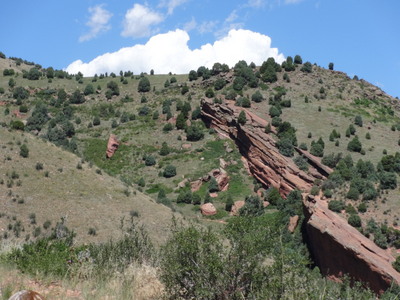
Saturday, 25 July 2015: Red Rocks and Nepalese food
Written 4 August 2015
Saturday morning, we reported as instructed to the house. As we entered, we admired the handsome, custom-made cut-sheet-metal sign in the yard adorned with the 3D likenesses of a couple of Pacific herring and saying, "The Herrings, a gentle paradocs . . . ." Jim has a Ph.D. (from Scripps), and Diane just retired from a career as an ob-gyn M.D.
Jim made yummy tostadas topped with refried beans, cheese, chorizo, and nopalitos, with fruit on the side. Delicious! He and Diane are both coffee fanatics, but they don't stock decaf (would not, I suspect, be caught dead with it in the house), so we stuck to tea.
All this was served on their patio, overlooking the 13th green. Diane is thinking of taking up golf, so we had a long conversation about golf rules and conventions, gear and equipment. I, of course, recommended by trusty Callaway GES set.

Eventually, we packed up and headed for the Red Rocks park and amphitheater in Morrison. It's built into terrain in and around the Fountain formation, the red rocks it's named for, which you see two outcrops of here. Similar dramatic examples are scattered for miles around. The "rattlesnake" rocks by the Fort restaurant are another. The illustrate the sharp angles to which originally horizontal rock strata have been pushed by the forces that formed the rockies.
Overhead, we spotted an immature hawk of some sort and, in addition to the swallows, a group of chimney swifts.
Just Google "Fountain formation" to see much more striking images than I was able to get.
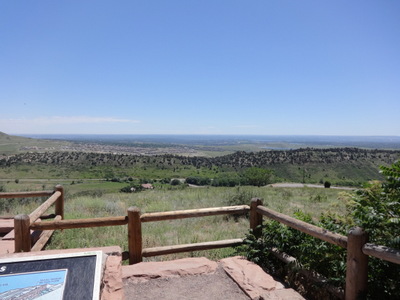
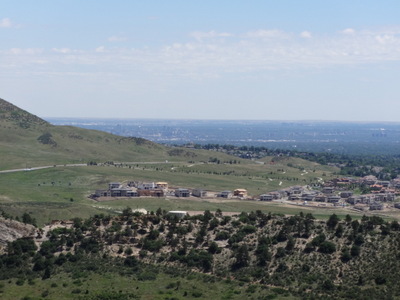 Near the top of the amphitheater was an overlook offering a panorama of the Front Range foothills, including an information panel with diagram of the of the many geological formations and tilted strata that could be seen and arrows naming the prominent structures. The ridge in the photo at the left is the Dakota Hogback, an outcrop of the Dakota Sandstone. I had always thought of sandstone as relative soft, but at least around here, sandstone and basalt are the most resistent to erosion, so they tend to stick up when all around them has been washed away.
Near the top of the amphitheater was an overlook offering a panorama of the Front Range foothills, including an information panel with diagram of the of the many geological formations and tilted strata that could be seen and arrows naming the prominent structures. The ridge in the photo at the left is the Dakota Hogback, an outcrop of the Dakota Sandstone. I had always thought of sandstone as relative soft, but at least around here, sandstone and basalt are the most resistent to erosion, so they tend to stick up when all around them has been washed away.
At the right is a different perspective on the hogback, showing a built-up area beyond it, down on the Laramie and Pierre shales. We were standing on part of the Fountain formation. The information panel also provided illustrations of fossils characteristic of the various strata, from tiny clams to ammonites, triceratops, brontosaurus, and wooly mammoths.
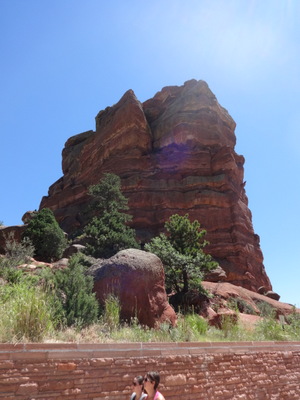
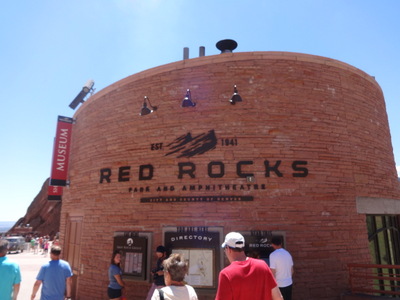 At the left here is a pinnacle that, from the color, must also be part of the Fountain formation. Admittedly, none of these rocks looks much like a fountain, but in fact, geological formations are named for their "type localities," the places where they were first discovered and described, so I hypothesized the existence of a place called "Fountain," and sure enough, Google reveals that it's a town just south of Colorado Springs.
At the left here is a pinnacle that, from the color, must also be part of the Fountain formation. Admittedly, none of these rocks looks much like a fountain, but in fact, geological formations are named for their "type localities," the places where they were first discovered and described, so I hypothesized the existence of a place called "Fountain," and sure enough, Google reveals that it's a town just south of Colorado Springs.
At the right is the entrance to the Amphitheater, in the center of the top edge. The curved brick structure houses a museum that, alas, we didn't have time to look at. The museum is named for the amphitheater's architect, Burnham Hoyt. I've never before encountered or heard of anyone with Burnham as a first name, and I have no idea whether we're related.
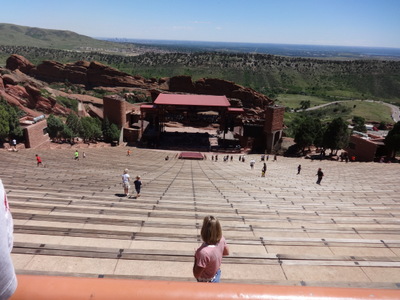
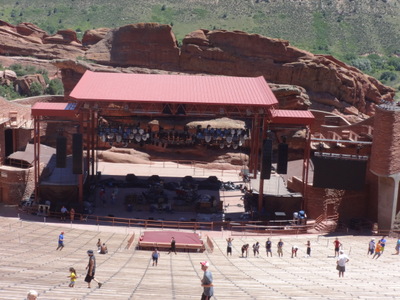 Here are a couple of views from the top of the amphitheater down toward the stage, the first "as is" and the second slightly telephotoed. Note the red rocks of the Fountain looming behind the stage and the Dakota Hogback beyond them.
Here are a couple of views from the top of the amphitheater down toward the stage, the first "as is" and the second slightly telephotoed. Note the red rocks of the Fountain looming behind the stage and the Dakota Hogback beyond them.
We'd deliberately come on a day without a concert, so that we'd be sure of being able to walk in and out unhindered. Tourists were everywhere, and a surprising number of athletes were taking advantage of the seating for their workouts. Some were jogging along one row of seats, turning at the end, climbing or descending one row, and jogging back along the next, all the way up or down. Others were running up the steps.
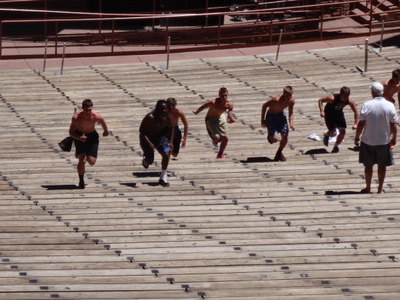
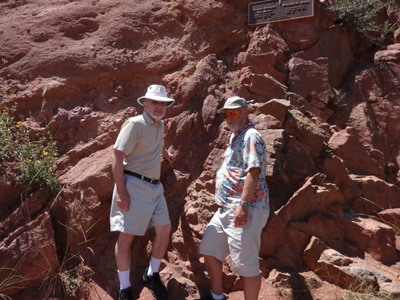 In this more highly telephotoed shot, you can see the group of athletes visible in the previous photo (to the right of the square red platformn near the bottom) sprinting up the steps. They would only go up 10 or 15 rows before stopping, climbing back down, puffing for a while, then doing it again. At one point (when I wasn't quick enough with the camera), they hopped up several rows, with their feet together!
In this more highly telephotoed shot, you can see the group of athletes visible in the previous photo (to the right of the square red platformn near the bottom) sprinting up the steps. They would only go up 10 or 15 rows before stopping, climbing back down, puffing for a while, then doing it again. At one point (when I wasn't quick enough with the camera), they hopped up several rows, with their feet together!
In the right-hand photo is the feature that Jim considered the primary reason for our visit to this site. David and Jim are standing on either side of a 14-million-year "unconformity" (a discontinuity in the geological strata). As the plaque on the rock above them says, David's side is the Fountain formation "red rocks," 300-million-year-old compacted sand and gravel. Jim's side is 1700-million-year-old pre-Cambrian gneiss (gray metamorphic rocks, stained red). The two strata meet at sharply different angles. Geologists find such unconformities extremely exiciting.
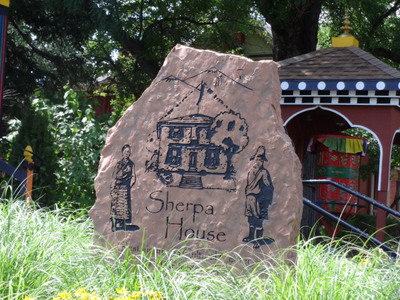
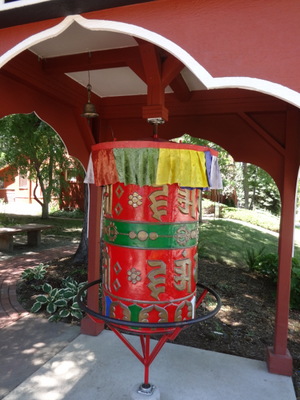 For lunch Jim took us to Golden, CO, to a restaurant called Sherpa House, serving Nepalese food. At the left here is the sign in their front yard. Signs etched into slabs of stone are a big thing here. I never seemed to have my camera ready, but the town of Estes Park, for example, marked its limits with eight-foot-high jagged slabs of engraved stone.
For lunch Jim took us to Golden, CO, to a restaurant called Sherpa House, serving Nepalese food. At the left here is the sign in their front yard. Signs etched into slabs of stone are a big thing here. I never seemed to have my camera ready, but the town of Estes Park, for example, marked its limits with eight-foot-high jagged slabs of engraved stone.
At the right is a largae, colorful prayer wheel, in its own little hut, visible behind the stone sign in the other photo. The restaurant occupied what had been a private house, or wooden construction, and the hut and prayer wheel give a good idea of the colors of the exterior and interior decor. It serves as a Nepalese cultural center as well as a restaurant, and part of its proceeds go back to Nepal.
I somehow failed to take photos of the food, which was very good and highly reminiscent of Indian cuisine. We sat under the café umbrellas in the back garden and ate tandoori chicken, chicken tikka masala, lamb curry, chana masala, daal soup, onion baazi, naan, rice, and gulab jamun. I had a mango lassi. They even had yak curry, though we didn't try it.
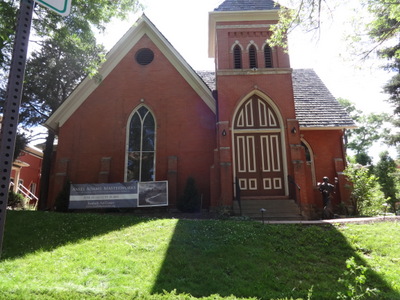
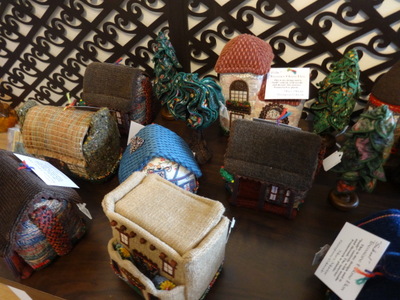 By the time we finished lunch and strolled around Golden a little, it was getting too late to go on to Jim's next geological highlight, but the nearby Foothills Art Center, clearly housed in what had been a church, was advertising Ansel Adams Masterworks. David's a fan, so we decided to go check that out.
By the time we finished lunch and strolled around Golden a little, it was getting too late to go on to Jim's next geological highlight, but the nearby Foothills Art Center, clearly housed in what had been a church, was advertising Ansel Adams Masterworks. David's a fan, so we decided to go check that out.
Unfortunately, it was $10 a head, which seemed steep for the hour we could spend, so we spent a pleasant interlude browsing the gift shop, admiring at the "sample" Adams photos on display in the lobby, and strolling around the outdoor sculpture garden.
Among the items in the gift shop were these wonderful little trees, houses, and other buildings, many of them functioning as "treasure boxes" and made entirely of fabric sewn with needle and thread. Charming, but out of my price range.
On the way back to Jim and Diane's, we passed the Coors operation, in the cleft between North and South Table Mountain. We'd been seeing different views of Table Mountain all day, and Jim had pointed out the basalt cap that protected it from erosion, resulting in two flat-topped mesas with a cleft between. Coors, until recently MolsonCoors and now apparently MillerCoors, also produces pipes and other manufactured products.
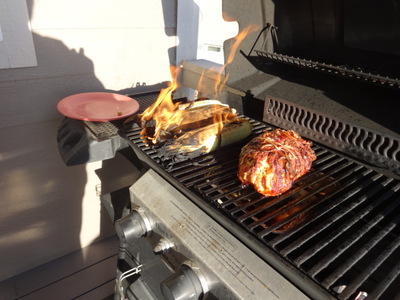
 Back at the home place, stephanie went out with friends, but Jim set about concocting a terrific dinner for us. At this point in the day, the sun was shining directly into the patio, where the porch had trapped the heat, so although dinner was grilled outdoors, we ate it inside.
Back at the home place, stephanie went out with friends, but Jim set about concocting a terrific dinner for us. At this point in the day, the sun was shining directly into the patio, where the porch had trapped the heat, so although dinner was grilled outdoors, we ate it inside.
Jim started with a boneless turkey breast half, butterflied it and pounded it a little thinner, fill it with turkey stuffing, wrapped the whole thing in bacon (how can you go wrong?!) secured with kitchen twine, and grilled it, covered, over indirect heat to an internal temperature of 160F.
At the left, you see it on the grill almost done, together with three ears of corn. Their husks had caught fire at this point, but they quickly burned out.
At the right is the cross section of the finished turkey bundle. It was outstandingly tender, moist, and flavorful; I'm going to have to try this at home!
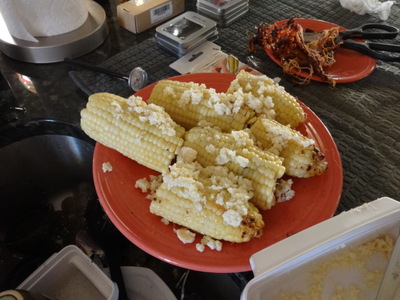
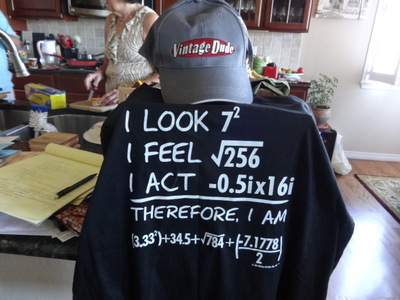 Here's a shot of the corn after grilling, shucked, broken in half, and dressed with a mixture of butter and cotillo cheese. Great.
Here's a shot of the corn after grilling, shucked, broken in half, and dressed with a mixture of butter and cotillo cheese. Great.
And finally, at the right, are the hat and shirt Jim got for his birthday. The hat says "Vintage Dude"; the shirt, in translation, says, "I look 49, I feel 16, I act 8, therefore I am 70."
Unfortunately, we had an early flight in the morning, so all too soon, we set off one more time for Stephanie's place, where we camped out, in great comfort, for another night.